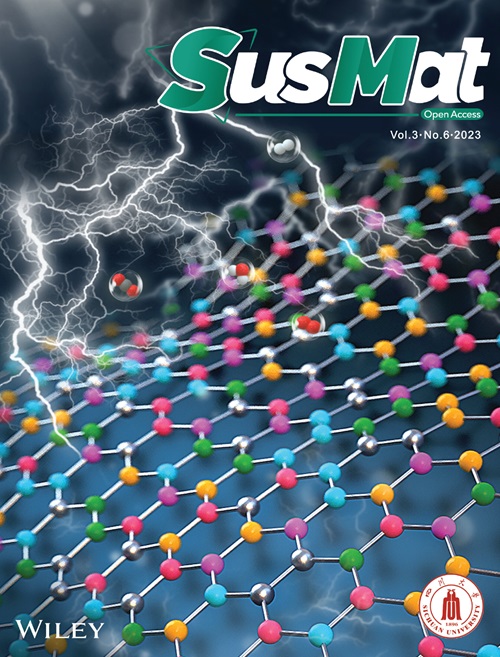Photo‐enhanced uranium recovery from spent fuel reprocessing wastewater via S‐scheme 2D/0D C3N5/Fe2O3 heterojunctions
IF 18.7
1区 材料科学
Q1 CHEMISTRY, MULTIDISCIPLINARY
引用次数: 0
Abstract
Re‐extracting environmentally transportable hexavalent uranium from wastewater produced by spent fuel reprocessing using the photocatalytic technology is a crucial strategy to avoid uranium pollution and recover nuclear fuel strategic resources. Here, we have designed S‐scheme 2D/0D C3N5/Fe2O3 heterojunction photocatalysts based on the built‐in electric field and the energy band bending theory, and have further revealed the immobilization process of hexavalent uranium conversion into relatively insoluble tetravalent uranium in terms of thermodynamics and kinetics. According to the results, the hexavalent uranium removal and recovery ratios in wastewater are as high as 93.38% and 83.58%, respectively. Besides, C3N5/Fe2O3 heterojunctions also exhibit satisfactory catalytic activity and selectivity even in the presence of excessive impurity cations (including Na+, K+, Ca2+, Mg2+, Sr2+, and Eu3+) or various organics (such as xylene, tributylphosphate, pyridine, tannic acid, citric acid, and oxalic acid). It is believed that this work can provide a potential opportunity for S‐scheme heterojunction photocatalysts to re‐enrich uranium from spent fuel wastewater.通过 S 型 2D/0D C3N5/Fe2O3 异质结从乏燃料后处理废水中进行光增强铀回收
利用光催化技术从乏燃料后处理产生的废水中重新提取环境可迁移的六价铀,是避免铀污染和回收核燃料战略资源的重要策略。在此,我们基于内置电场和能带弯曲理论设计了 S 型 2D/0D C3N5/Fe2O3 异质结光催化剂,并从热力学和动力学方面进一步揭示了六价铀转化为相对不溶的四价铀的固定化过程。结果表明,废水中六价铀的去除率和回收率分别高达 93.38% 和 83.58%。此外,即使在过量杂质阳离子(包括 Na+、K+、Ca2+、Mg2+、Sr2+ 和 Eu3+)或各种有机物(如二甲苯、磷酸三丁酯、吡啶、单宁酸、柠檬酸和草酸)存在的情况下,C3N5/Fe2O3 异质结也表现出令人满意的催化活性和选择性。相信这项工作能为 S 型异质结光催化剂从乏燃料废水中再富集铀提供一个潜在的机会。
本文章由计算机程序翻译,如有差异,请以英文原文为准。
求助全文
约1分钟内获得全文
求助全文
来源期刊
自引率
4.20%
发文量
0
期刊介绍:
SusMat aims to publish interdisciplinary and balanced research on sustainable development in various areas including materials science, engineering, chemistry, physics, and ecology. The journal focuses on sustainable materials and their impact on energy and the environment. The topics covered include environment-friendly materials, green catalysis, clean energy, and waste treatment and management. The readership includes materials scientists, engineers, chemists, physicists, energy and environment researchers, and policy makers. The journal is indexed in CAS, Current Contents, DOAJ, Science Citation Index Expanded, and Web of Science. The journal highly values innovative multidisciplinary research with wide impact.

 求助内容:
求助内容: 应助结果提醒方式:
应助结果提醒方式:


